Amalie Robert Estate Vintage Update: 2013 Harvest After Action Report (AAR)
Hello and Welcome,
This is the 2013 Harvest After Action Report (AAR.)
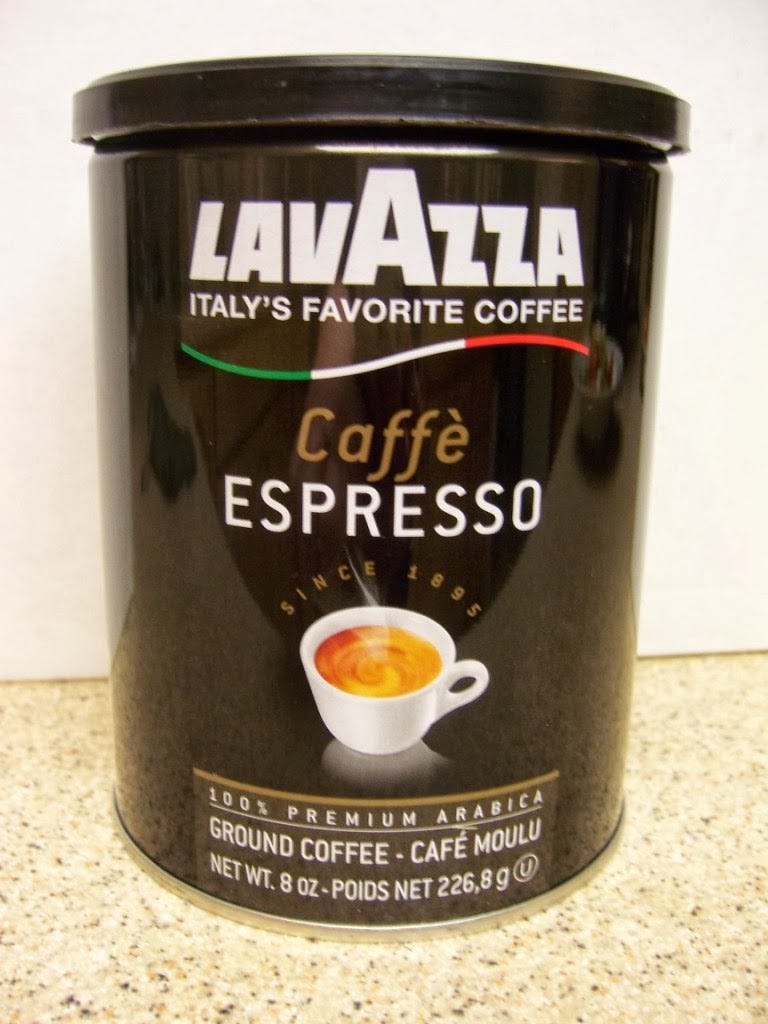
Consciousness slowly permeates the psyche hovering precariously above a cup of predawn, harvest morning accelerant. Ernie’s lenses are holding heavy condensation, his brain the fog. “This is All Fogged Up!” Consciousness achieved at “O‘Dark Thirty” – Check! You know you are in for a long day when your first chore in the morning is to get out there and lift the fog.
And so it was. Fog or not, harvest began the morning of October 4, 2013. And despite what you may have heard, it was a lovely morning. The tractors started, the tires on the trailers were not flat, the crew arrived and we picked some grapes. Oh, did we pick some grapes.
The road to harvest 2013 was just as eventful as any we can remember, and we have been at this since the turn of the century. Overall, the summer was nice and the humans were really enjoying it. The vines were more on a collision course with high sugars and potentially overcooked flavors. We tried to reign in the vintage by hedging a short canopy that would deny the vines more photosynthetic activity than they needed. We also kept a tight trim on the grassed rows to preserve soil moisture for later into the season. Little did we know… Check out Ernie’s new flail mower – it swings both ways!
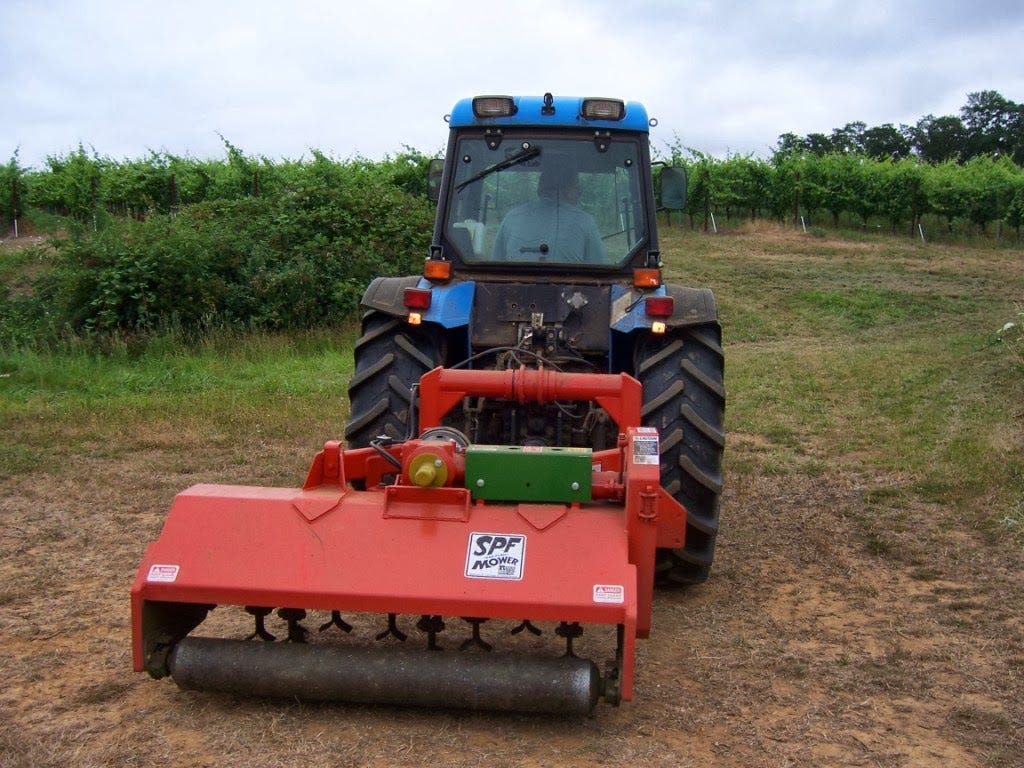
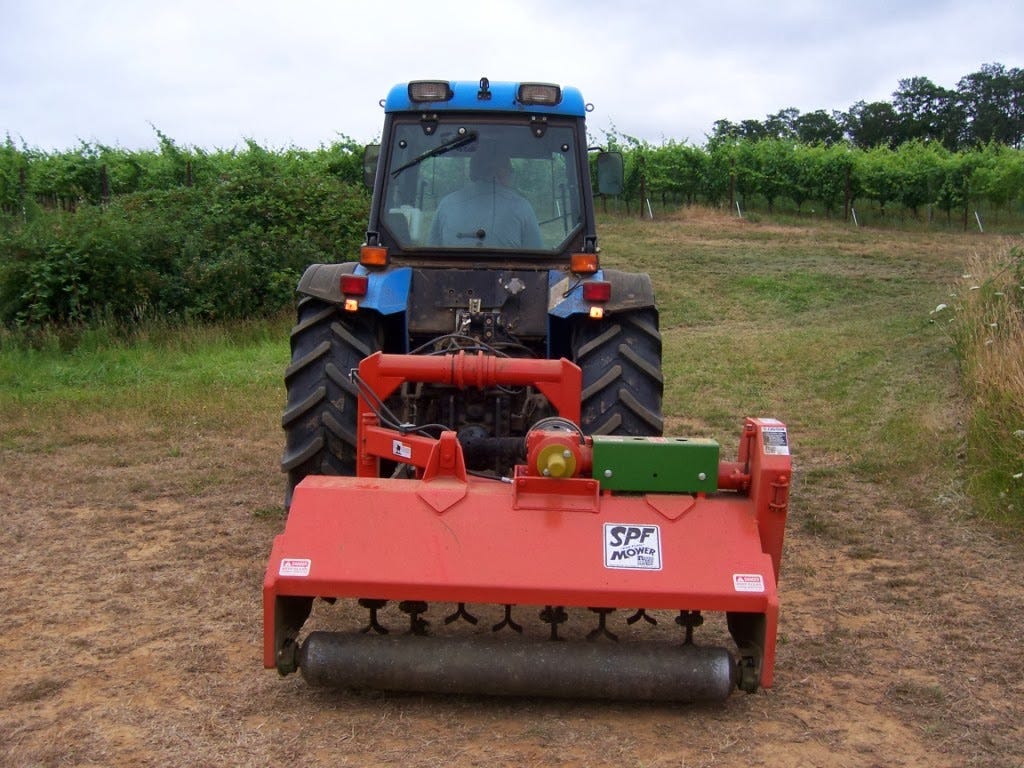
But we can only dance to the tune we are given, and to be brutally honest it is hard to dance in size 12 steel toed, waterproof work boots. It is not a pretty sight. So we hurtle along to harvest with everyone else, hoping for the best and planning for the worst. Generally speaking, this is known as farming.
Life really is about 80% just showing up to work every day. The other 20% of it is doing the right thing at the right time once you get there. And the key to knowing what that is comes from experience, which is what you get when you don’t get what you want. Farming: Can’t win, can’t quit, can’t break even. But it’s all good, mostly, and some of it is even farmin’ great! (Bert, that’s for you. Best of luck to you in your own personal, potential, agrarian endeavor.)
As farmers, one of the things we are keen to learn early in the year is when we think we will be harvesting. We determine this with Pinot Noir by recording when the vines flower and adding 105 days for the resulting wineberries to mature. That gives us an idea of what kind of harvest we willbe looking at. Late harvests like 2011 when we started on October 23rdmean we will be out there late in October and November. We will have a harvest all right; Right after all of the birds, rain and resulting rot.
In 2013 the numbers said we should start harvest around September 19th. HA! Even the rules based, computer science, CPA numbers guy knew that was not going to happen. But it could have, except for the fact we were both out on the road selling wine through September 22nd.
The 2013 growing season was barreling down on us like 2003. It was warm at night and got hot during the day. The vines did not skip a beat and kept building sugars – that’s what they do. The hotter it gets, up to just about 100 degrees, the faster they go. And warm nighttime temperatures simply exacerbate the issue. That moves all of the photosynthetic energy stored in the leaf around the vine at night resulting in faster ripening. That is like hitting the afterburners and the surest way to speed up sugar accumulation, while it does nothing for advancing aroma and flavor development. And we don’t want that. That is what Zinfandel is for.
Balance in the vineyard gets a lot of airtime, mostly hot airtime. For us, balance in the vineyard means we can archive great aroma and flavor development in the wineberry skins before we achieve excessive sugars resulting in high alcohols. We have a few tools at our disposal as mentioned above, but nothing even comes close to Mother Nature’s repertoire.
We would like to take a moment now to introduce you to Typhoon Pabuk. This was a late breaking development toward the end of September that caught the weather guessers out. As everyone was planning an early harvest before sugar accumulations meant port style wines, Typhoon Pabuk was headed to Japan to rain on their parade. But they would have none of it. So all dressed up with nowhere to blow, Typhoon Pabuk heads for a beer in Portland and brings over 9 inches of rain along for good measure. Note: It was Woody Allen that said “If you want to make God laugh, tell him your plans.”
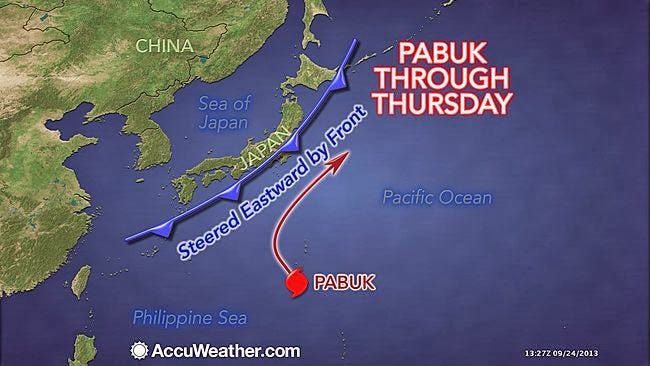
This is all fogged up! That was the day before Typhoon Pabuk started showering us with a significant amount of the Pacific Ocean. Of course we looked for some blocks to harvest before the rains, but it was not to be. The sugars were certainly in the zone, but the seeds were still green, the skins tasted like unripe bananas and the pulp around the seeds was still firm. We thought you could make alcohol from this fruit, but not great wine. We waited for optimal fruit ripeness before we harvested and that meant riding the storm out. Please note, optimal is a relative term but it is site and vintage specific. Some people, they say, were ready before the rains. Lucky, lucky bastards!
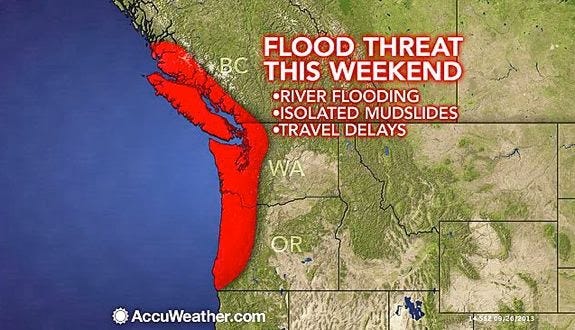
By now the estimated harvest date was a distant memory. The naïve notion that we would have a low stress, enjoyable day of harvesting wonderfully delectable fruit at our leisure begged for life. Well, there was clearly only one response to that notion: NO FARMING WAY!
If you grew up in a rural area where cattle were raised, you will understand this reference: “It was like a cow standing over a flat rock!” If you were more of an urbanite, you may better relate to this: “It was like trying to get a drink from a fire hose!” If you were growing Pinot Noir in the North Willamette Valley you were saying things that can not be printed in this space.
There was plenty of time to consider past vintages and the vagaries that surrounded them. Comments that referenced how “fun and easy” 2007 was, and that the wines have now handsomely rewarded cellaring.
How 2008 was a repeat of 2007 until the last 3 weeks when the sun came out and, with cool temperatures, really saved our acids. Nice wines at this point in history.
Why 2009 didn’t seem ripe at the time, but has developed into a very expressive wine showing perhaps a bit more leg than is completely necessary.
Vintage 2010 and Alfred Hitchcock’s “The Birds” will soon be referred to as synonyms on Wikipedia. We saw 3,600 bottles worth of wine leave the vineyard by wing.
There is a very special place in every winegrower’s heart for 2011. The latest vintage on record and a bitterly cold end of the season left many with an uncontrollable physical reaction of a middle digit to the vintage. The best of this vintage willmost certainly outlive those who grew it. (Note: This is using the FISH inventory accounting method – First In Still Here.)
Could 2012 be the gift we have so tiredly toiled for? The wines, while still in barrel, show all the components to be there. The only thing missing is time. Don’t you just hate that?
All good things must come to an end and for us that meant the Pacific Ocean stopped falling out of the sky on October 2nd. However this is not true with bad things. We could have been visited by the ghost of vintage 2007 past and had the rain continue for another week – or more. And then throw in the 2010 voracious bird activity with 2011 harvest operations starting on October 23rd and that would have been really farming bad. Instead, we just got the bird activity and some late harvest.
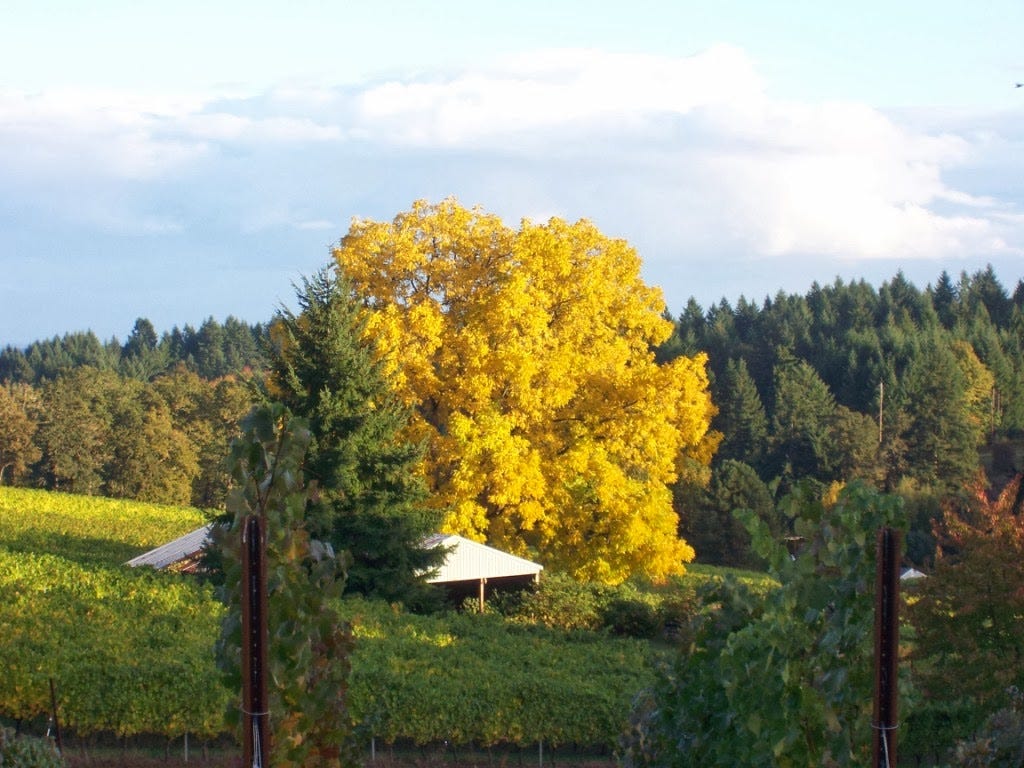
So we waited for the soil to dry up a bit for tractor and human safety and we commenced harvest operations on October 4th, just 15 days later than our estimate – pretty farming close. It took an entire day for the birds to find the first easy pickin’s and 30 vines were denuded. They work on fish and they work on birds, so we rolled out the nets. However we lost all the Wadenswil in block 35, a high elevation block near the forest. The netting budget is doubling next year.
We prepare a “Harvest Target Package” for each day of harvest to outline what blocks are picked in what order. We are looking for the optimal time to take the wineberries from each block that represents a specific clone to rootstock combination. The birds must have a mole in the operations somewhere, most likely turned by the rabbit who hangs out with the quail in block 2. Because every where we go to start harvest the birds are already there. No matter, we endeavor to persevere.
As you most likely know, white wines from this vintage willbe in short supply. Ernie likes to say that when some guy in Tokyo sneezes, we get rot in our Chardonnay. Well, imagine everyone in China, Japan and all of Eurasia sneezing and that was Typhoon Pabuk. We were able to take enough clean, optimally ripe fruit to ferment the Heirloom Cameo and a very limited amount of Her Silhouette this year. The rest was a lost cause to Botrytis.
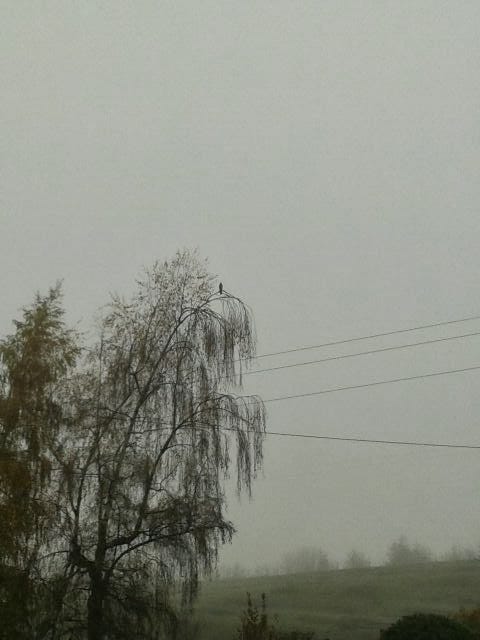
The great thing about harvest 2013 was the weather. Once Typhoon Pabuk blew out of town, the weather improved substantially. First off it was dry, the sun was out most of the time and we had cool breezes. This held through about the 15th of the month which is when we finished up everything but the Syrah and Viognier. With the exception of the Chardonnay, the fruit was remarkably clean. There was apparently some black mold making its way through the valley, but it didn’t seem to find us. The deer, however, did and we enjoyed their company one morning during harvest. We say enjoy because they did not fit the definition of a problem. To wit: a problem is something that annoys you AND that you can do something about. We couldn’t do anything about the deer eating our Pinot Noir, so we “enjoyed” them. However, we do have friends in high places.
The Pinot Noir and Pinot Meunier came in beautifully. The dried and desiccated berries got pumped up with the rains but miraculously did not split. The net result was more hang time and aroma flavor development. The first fruit to come in registered around 21 brix and toward the end of harvest we were seeing 24 brix Pinot Noir providing 12.5% to 13.5% alcohols. The seeds were brown and the flavors were there. Not so bad after all, eh?
We held the Syrah and Viognier until it looked like it was going back to full on rain mode. We took the miniscule amount of Viognier a few days before the Halloween pick of Syrah.
We fermented the 13 gallons of Viognier in a tall beer keg this year. This means you will have to arm wrestle Ernie for each and every bottle. Unless you are on the A-List. Then you will have to arm wrestle Dena instead. We anticipate about 5 cases produced and 4 cases bottled.
The Syrah had a bit of Botrytis, something we generally look for, but do not see. That meant a fair bit of sorting, cluster by cluster and berry by berry to insure we had a clean fermenter. And that is all there was this year, just one fermenter, enough for 2 barrels.
Overall our yields were a bit low at about 55 tons of Chardonnay, Pinot Noir, Pinot Meunier Syrah and Viognier from 30 acres. Without the gift from the Typhoon Pabuk, we could have easily seen the yields lowered another 20 to 40% with potential alcohols in the range for Grappa! Well, who knew that all of that rain could actually improve the vintage?
Chardonnay is the most popular wine on the planet and in 2013 three ways is how we have it. But do you recall, the most famous sweet wines of all? That’s right Sauternes fans, we have a Botrytis Chardonnay in 2013. After all the Pinot Noir was picked, we went out to see just what we could have done differently in growing our Chardonnay. We concluded the only thing would have been to pick it under ripe.
Well, you win some, you lose some and some get Botryotinia Fuckeliana. And that’s what we got! The rains got the infection started, but the dry weather afterwards kept it in check, and the little fungal spores worked their Noble Rot magic. Seventy buckets of naturally desiccated Chardonnay grapes yielded about 70 gallons of juice – the hard way. The sorting here was berry by berry. While we had mostly Botryotinia Fuckeliana, we also had plain old rot. So we sorted the Plebian from the Noble.
This is unchartered territory for Ernie (so what’s new?) so he asked (OK, that’s new!) the only person he thought would know how to handle this kind of fruit – Dick Erath. As “Conspiring Winemaker,” Dick shared his thoughts and experience as well as an exemplar of his efforts with a Late Harvest Riesling from 1997. Ernie opened several other late harvest wines as “learning opportunities” but after all of the R&D, the balance of Dick’s 1997 Late Harvest Relishing won the day.
The juice was something you just had to experience to believe. After whole berry pressing the raisined fruit, the juice read 43.4 Brix. We had to rack that from the fermentation floor down to the tank room. The juice was so viscous it was like moving honey. The aromas and flavors were of grilled pineapple and yellow roses with a big hit of funky. We will most likely account for this wine using the FISH inventory method.
At the time of this writing our red fermentations are just finishing up. We typically need about 4 weeks in these fermenters to go from optimal fruit to fermented wine as we do not add commercial yeast. Instead we rely on Amalie Robert Estate grown yeast and about 25% whole clusters and it makes all the difference in what you smell and more importantly what you don’t.
You won’t smell any of that commercially produced, cultured, dry yeast. You will smell the yeast grown right here on the little wineberries that provides a unique aroma profile to our wines. You can read about commercial yeast aroma properties here. And then you can read about “Re-Engineered” yeast here. We just rely on our own Amalie Robert Estate “Designer” yeast and you can too!
Arguably, one of the more respected wine reviewers recently posted a question on winophiliaregarding what job winemakers never delegate. The time to respond was here and gone and Ernie missed it. But we thought about it.
For Ernie, the thing that is the most important is smelling each and every Pinot Noir fermenter (The Syrah fermenter is something other and we have to keep the ladder away from it, lest Ernie crawls in there.) This begins as we empty our tote bins of hand harvest fruit onto an elevator for a second and final inspection. All of our fruit is sorted in the field as it is harvested. This is our chance to catch anything that may have been missed in the field.
The first portion of fruit always goes in “whole cluster” meaning the grapes go in the fermenter just as they were hanging on the vine. The remaining fruit is destemmed over the top. We add a little sulfur dioxide to slow down any spoilage organisms before our Estate Grown “Designer” yeast can take over and dominate the fermentation to dryness.
This process takes about 4 weeks from filling a fermenter with 3,000 pounds of grapes to emptying about 240 gallons of wine into barrels. This gives Ernie around 28 days to smell how each fermenter is developing. The first week or so is pretty bland. The only thing to be alert to is off aromas from spoilage. A little can add complexity to the finished wine, a little more can be used as a blending component, and a lot can spell “VINEGAR.” We swing toward the little side, if any at all.
The second week is where things really smell nice. During punch down is the time to get a look at the early juice color and get a whiff of pure Pinot Noir just starting to ferment at maybe 58 - 60 degrees. It’s still pretty cool, but giving off the most ethereal aromas. It is this aroma we work so hard to steward into the bottle. If you would like to sign up for punch down next year, and get a smell of this nectar, please contact Dena. She will be glad you did! (Wine reviewers also welcome!)
The third week sees a significant amount of fermentation and it is hard to get a good whiff without your body’s involuntary response to not die from asphyxia pulling you back. Here our temperatures spike up to about 80 degrees for a day or so. Still a pretty cool fermentation all in all, and while the aromas are interesting, the aromas from the week before linger. The fourth week is when the cap of floating berries starts to fall signaling it is time to get into a barrel for a long winters rest.
While most anyone can smell for spoilage, it is the pure aromas of Pinot Noir that are not to be missed. This once of year experience revisits us during blending trials. Those pure aromas matched with stem tannins, firm acidity and balanced oak, guide us to our final blends.
From the fermentation floor, we go through the holes in the floor to fill barrels with young wine. It is in this 18 month barrel maturation period that the wines soften the aggressive stem tannins from whole cluster fermentation, convert the malic acid to lactic acid and develop their alluring bouquet.
All in all, harvest 2013 was as unique as any we have experienced. The twists and turns were unpredictable and the resulting fruit has all of the early indications of a very good and hopefully a once in a lifetime vintage - like 2011. Certainly it is the vintage of the year and no one can dispute that. We will just need to add some time.
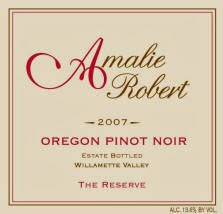
Meanwhile, how ‘bout we open one of those sublime 2007 Oregon Pinot Noirs? We did for the Wine Advocate reviewer Mr. David Schildknecht and here is what he had to say about our 2007 “The Reserve” Pinot Noir.
“Rowan, heliotrope, hibiscus, and in fact an entire floral sachet emanate from the glass of Amalie Robert 2007 Pinot Noir Reserve, resembling – but also heightening – aromatic behavior I’ve experienced this year in a number of wines harvested in this “vintage from hell.” Relatively low tannin – like high perfume – is a theme here, but there is an invigorating ping born of fresh red berry acidity allied to subtle crunch of berry seeds on an otherwise polished palate. Reflecting the warmth that led up to 2007’s miseries, hints of caramel are allied to entirely ripe expressions of red fruits, and 13.6% alcohol reveals itself as expansiveness without weight or heat. A smoky aura of burley tobacco mingles with the profuse inner-mouth perfume of this buoyant, vibrant Pinot that finishes with fine, long, mouthwateringly salt-tinged length: not gripping but both stimulating and soothing. I can only hazard a guess as to how long it will remain in such a flattering state, but nothing I taste now suggests it will be less than another couple of years.” 94 Points.
And we found his follow-on comments especially rewarding:
“…Dallasgrowers Dena Drews and Ernie Pink …. showed me this July three of their reserve bottlings and thereby altered my perception of their endeavors. Since these are produced in only one- or two-barrel quantities, they offer an extreme instance of a phenomenon encountered at numerous Willametteaddresses, whose really exciting releases are extremely limited. But they also testify, importantly, to what is possible; and what’s possible from this site in these hands revealed itself to be extraordinary! What’s more, this mini-vertical of reserve bottlings served me with the most amazing among numerous admonitions I received from wines this year to reconsider received opinion about vintages, and in particular the potential of vintage 2007…”
Drink ‘em if you got ‘em…
Kindest Regards from Vintage 2007,
Dena & Ernie



